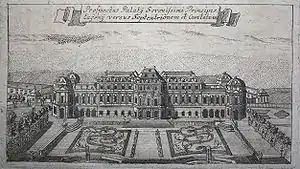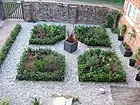Parterre
A parterre is a formal garden constructed on a level substrate, consisting of plant beds, typically in symmetrical patterns, which are separated and connected by paths. The borders of the plant beds may be formed with stone or tightly pruned hedging, and their interiors may be planted with flowers or other plants or filled with mulch or gravel. The paths are constituted with gravel or turf grass.[1]


French parterres originated in the gardens of the French Renaissance of the 15th century and often had the form of knot gardens. Later, in the 17th century Baroque garden, they became more elaborate and stylised. The French parterre reached its greatest development at the Palace of Versailles, which inspired many similar parterres throughout Europe.[2]
History
Claude Mollet, the founder of a dynasty of nurserymen-designers that lasted into the 18th century, developed the parterre in France. His inspiration in developing the 16th-century patterned compartimens, i. e. simple interlaces formed of herbs, either open and infilled with sand, or closed and filled with flowers, was the painter Etienne du Pérac, who returned from Italy to the Château d'Anet near Dreux, France where he and Mollet were working. C. 1595 Mollet introduced compartment-patterned parterres to the royal gardens of Saint-Germain-en-Laye and Fontainebleau; the fully developed scrolling embroidery-like parterres en broderie first appear in Alexandre Francini's engraved views of the revised horticultural plans of Fontainebleau and Saint-Germain-en-Laye in 1614.[3]

Clipped boxwood met with resistance from horticultural patrons for its "naughtie smell" as the herbalist Gervase Markham described it. By 1638, Jacques Boyceau described the range of designs in boxwood that a horticulturist should be able to cultivate:
Parterres are the low embellishments of gardens, which have great grace, especially when seen from an elevated position: they are made of borders of several shrubs and sub-shrubs of various colours, fashioned in different manners, as compartments, foliage, embroideries (passements), moresques, arabesques, grotesques, guilloches, rosettes, sunbursts (gloires), escutcheons, coats-of-arms, monograms and emblems (devises).[4]
By the 1630s, elaborate parterres de broderie appeared at Wilton House in Wilton, England that were so magnificent that they were engraved, which engraving is the only remaining trace of them. "Parterres de pelouse" or "parterres de gazon" denominate cutwork parterres of low growing herbs, e. g. camomile, as much as closely scythed turf grass. The separation of plant beds of a pareterre is denominated an "alley of compartiment".
Parterre gardens lost favour in the 18th century and were superseded by naturalistic English landscape gardens, which emerged in England in the 1720s. However, in the 19th century parterre gardens were revived, coinciding with the rise of Neo-Renaissance architecture and the fashion for carpet bedding, which was realized by the annual mass planting of non-hardy flowers as segments of color which constituted a design. Level substrates and a raised vantage point from which to view the design were required, and so the parterre was revived in a modified style.[5][6][7][8]
Examples
.jpg.webp)

At Kensington Palace the planting of the parterres was by Henry Wise, whose nursery was nearby at Brompton. In an engraving from 1707–1708, (illustration, right), the up-to-date Baroque designs of each section are clipped scrolling designs, symmetrical around a centre, in low hedging punctuated by trees formally clipped into cones; however, their traditional 17th century layout, a broad central gravel walk dividing paired plats, each subdivided in four, appears to have survived from the Palace's former (pre-1689) existence as Nottingham House. Subsidiary wings have subsidiary parterres, with no attempt at overall integration. At Prince Eugene's Belvedere Palace, Vienna, a sunken parterre before the façade that faced the city was flanked in a traditional fashion with raised walks from which the pattern could best be appreciated. To either side, walls with busts on herm pedestals backed by young trees screen the parterre from the flanking garden spaces. Formal baroque patterns have given way to symmetrical paired free scrolling rococo arabesques, against the gravel ground. Little attempt seems to have been made to fit the framework to the shape of the parterre. Beyond (in the shadowed near foreground) paired basins have central jets of water.
In the UK, modern parterres exist at Trereife House in Penzance (Cornwall), at Drumlanrig Castle in Dumfriesshire and at Bodysgallen Hall near Llandudno.[9] Examples can also be found in Ireland, such as at Birr Castle. One of the largest in Britain is at Cliveden in Buckinghamshire, which covers an area of 4 acres (1.6 ha); it consists of symmetrical wedge-shaped beds filled with Nepeta ("catmint"), Santolina and Senecio, edged with box hedges. Sentinel pyramids of yew stand at the corners. Some early knot gardens have been covered over by lawn or other landscaping but the traces are visible as undulations in the present day landscape. An example of this phenomenon is the early 17th-century garden of Muchalls Castle in Scotland. At Charlecote Park in Warwickshire the original parterre from the 1800s has been recreated on the terrace overlooking the river.[10][11]
Gallery
- Historic gardens
 Parterre at Waddesdon Manor, 1910
Parterre at Waddesdon Manor, 1910 Parterre at Schloss Hof in Austria
Parterre at Schloss Hof in Austria Parterre at Charlecote Park, July 2014
Parterre at Charlecote Park, July 2014 The left hand side of the completely symmetrical parterre at Waddesdon Manor, England
The left hand side of the completely symmetrical parterre at Waddesdon Manor, England.jpg.webp) Summer Garden in St Petersburg, 1716
Summer Garden in St Petersburg, 1716 The Belvedere Palace, Vienna, engraving, 1753
The Belvedere Palace, Vienna, engraving, 1753 Parterres of the Saxon Garden in Warsaw, 1765
Parterres of the Saxon Garden in Warsaw, 1765
- Contemporary gardens
 Parterre beds laid out ready for planting, with paths gravelled. One half of a symmetrical design flanking a path shown
Parterre beds laid out ready for planting, with paths gravelled. One half of a symmetrical design flanking a path shown Another view of the bed three months after planting
Another view of the bed three months after planting The same bed 18 months after planting
The same bed 18 months after planting
See also
References
- Suzanne Staubach (29 October 2019). A Garden Miscellany: An Illustrated Guide to the Elements of the Garden pp. 148. Timber Press. ISBN 978-1-60469-977-7.
- Derek Plint Clifford (1967). A history of garden design. Praeger.
- "Archived copy" (PDF). Archived from the original (PDF) on 2005-05-08. Retrieved 2005-06-30.CS1 maint: archived copy as title (link)
- Jacques Boyceau, Traité du iardinage selon les raisons de la nature et de l’art, pp. 81-2, as quoted by [Mark?] Laird.
- C. F. Ferris (1837). The Parterre; Or, Whole Art of Forming Flower Gardens. Bull. pp. 39–.
- Richard Bradley (1718). New Improvements of Planting and Gardening: Both Philosophical and Practical; Explaining the Motion of the Sapp and Generation of Plants. W. Mears.
- A.D. d'Argenville. The theory and practice of gardening. Рипол Классик. ISBN 978-5-87957-770-9.
- Judith Wade Bernardi; Judith Wade (14 September 2002). Italian gardens. Rizzoli. ISBN 9780847824953.
- Trereife Park
- Marie Luise Schroeter Gothein (11 September 2014). A History of Garden Art. Cambridge University Press. ISBN 978-1-108-07615-9.
- Kenneth Woodbridge (1986). Princely Gardens: The Origins and Development of the French Formal Style. Random House Incorporated. ISBN 978-0-8478-0684-3.
 This article incorporates text from a publication now in the public domain: Chambers, Ephraim, ed. (1728). Cyclopædia, or an Universal Dictionary of Arts and Sciences (1st ed.). James and John Knapton, et al. Missing or empty
This article incorporates text from a publication now in the public domain: Chambers, Ephraim, ed. (1728). Cyclopædia, or an Universal Dictionary of Arts and Sciences (1st ed.). James and John Knapton, et al. Missing or empty |title=(help)